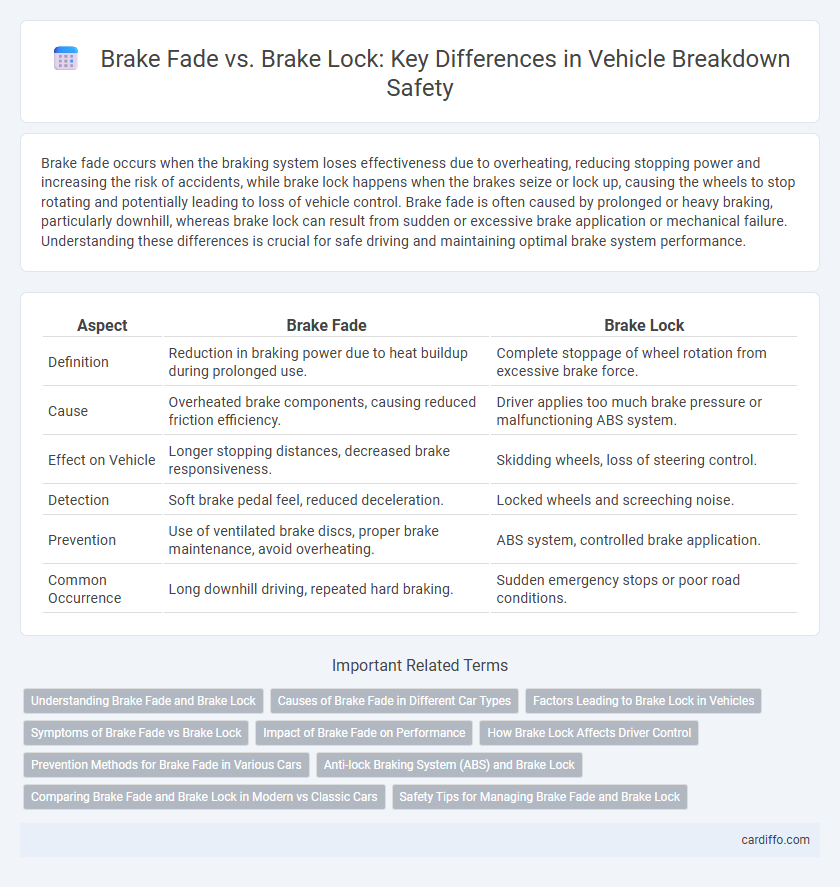Brake fade occurs when the braking system loses effectiveness due to overheating, reducing stopping power and increasing the risk of accidents, while brake lock happens when the brakes seize or lock up, causing the wheels to stop rotating and potentially leading to loss of vehicle control. Brake fade is often caused by prolonged or heavy braking, particularly downhill, whereas brake lock can result from sudden or excessive brake application or mechanical failure. Understanding these differences is crucial for safe driving and maintaining optimal brake system performance.
Table of Comparison
| Aspect | Brake Fade | Brake Lock |
|---|---|---|
| Definition | Reduction in braking power due to heat buildup during prolonged use. | Complete stoppage of wheel rotation from excessive brake force. |
| Cause | Overheated brake components, causing reduced friction efficiency. | Driver applies too much brake pressure or malfunctioning ABS system. |
| Effect on Vehicle | Longer stopping distances, decreased brake responsiveness. | Skidding wheels, loss of steering control. |
| Detection | Soft brake pedal feel, reduced deceleration. | Locked wheels and screeching noise. |
| Prevention | Use of ventilated brake discs, proper brake maintenance, avoid overheating. | ABS system, controlled brake application. |
| Common Occurrence | Long downhill driving, repeated hard braking. | Sudden emergency stops or poor road conditions. |
Understanding Brake Fade and Brake Lock
Brake fade occurs when the braking system overheats, causing a reduction in friction between the brake pads and rotors, which leads to decreased stopping power and longer braking distances. Brake lock happens when the wheels stop rotating during braking, causing loss of control and potential skidding, especially on slippery surfaces. Understanding these phenomena is crucial for maintaining optimal brake performance and ensuring vehicle safety under various driving conditions.
Causes of Brake Fade in Different Car Types
Brake fade occurs when excessive heat buildup reduces the friction between brake pads and rotors, hampering braking efficiency. In front-wheel-drive cars, brake fade often results from front brake overheating due to higher load during acceleration and cornering, whereas rear-wheel-drive cars may experience fade more evenly distributed between front and rear brakes. Performance and heavy-duty vehicles are more prone to brake fade caused by aggressive driving styles, steep descents, or towing, which generate sustained high temperatures and accelerate pad wear.
Factors Leading to Brake Lock in Vehicles
Brake lock occurs when excessive force is applied to the brake pedal, causing the wheels to stop rotating and lose traction with the road surface. Contributing factors include poor brake system maintenance, uneven brake pressure distribution, and slippery road conditions that reduce tire grip. Additionally, malfunctioning anti-lock braking systems (ABS) and worn brake pads can exacerbate the risk of brake lock, especially during sudden or hard braking.
Symptoms of Brake Fade vs Brake Lock
Brake fade presents as a gradual reduction in braking power, often accompanied by a spongy brake pedal and increased stopping distance, typically occurring after prolonged or intense braking. Brake lock, on the other hand, is characterized by the wheels locking up suddenly, causing skidding and loss of steering control. Recognizing the difference between the soft pedal feel of brake fade and the abrupt wheel lock of brake lock is crucial for safe vehicle handling.
Impact of Brake Fade on Performance
Brake fade significantly reduces braking performance by decreasing friction between brake pads and rotors, leading to longer stopping distances and compromised vehicle control. Unlike brake lock, where wheels seize and lose traction, brake fade causes gradual loss of braking efficiency due to heat buildup and pad material degradation. This degradation under high temperatures impairs consistent braking force, increasing the risk of accidents during prolonged or intense braking scenarios.
How Brake Lock Affects Driver Control
Brake lock occurs when the wheels stop rotating while the vehicle is still moving, causing a loss of steering control and increased risk of skidding. Unlike brake fade, which reduces stopping power gradually, brake lock results in immediate and total loss of traction. This sudden loss of control can lead to dangerous situations, especially during emergency braking or on slippery surfaces.
Prevention Methods for Brake Fade in Various Cars
Brake fade can be prevented by maintaining proper brake fluid levels and using high-quality brake pads with superior heat resistance. Regular inspection of brake components, including rotors and calipers, ensures optimal heat dissipation and performance under heavy braking conditions. Upgrading to ventilated or slotted rotors helps various cars reduce overheating, minimizing brake fade during intense driving scenarios.
Anti-lock Braking System (ABS) and Brake Lock
Brake fade occurs when excessive heat reduces brake pad friction, leading to diminished stopping power, whereas brake lock happens when wheels stop rotating, causing loss of steering control. Anti-lock Braking System (ABS) prevents brake lock by modulating brake pressure, maintaining wheel rotation and improving vehicle stability during emergency braking. In contrast, ABS does not directly address brake fade, which requires cooling or brake component inspection to restore effective braking performance.
Comparing Brake Fade and Brake Lock in Modern vs Classic Cars
Brake fade occurs when modern anti-lock braking systems (ABS) effectively prevent wheel lockup, whereas classic cars without ABS are prone to brake lock under heavy braking. Modern cars benefit from advanced materials and cooling systems that reduce brake fade, while classic cars often experience quicker performance degradation due to outdated drum brakes. Comparing both, modern vehicles provide consistent stopping power and safety, whereas classic cars require more skill to avoid both brake fade and lock.
Safety Tips for Managing Brake Fade and Brake Lock
To manage brake fade and brake lock safely, regularly inspect brake pads and fluid levels to ensure optimal braking performance. Use gradual, controlled braking to prevent overheating and avoid sudden, hard stops that increase the risk of brake lock. Maintain proper tire pressure and adjust driving speed on steep descents to enhance vehicle control and reduce brake system strain.
Brake fade vs brake lock Infographic

 cardiffo.com
cardiffo.com